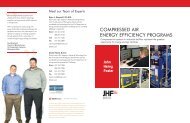The Turbo Air® 3000 Centrifugal Compressor Compressor Handbook
The Turbo Air® 3000 Centrifugal Compressor Compressor Handbook
The Turbo Air® 3000 Centrifugal Compressor Compressor Handbook
You also want an ePaper? Increase the reach of your titles
YUMPU automatically turns print PDFs into web optimized ePapers that Google loves.
Figure A—21. <strong>Compressor</strong> Lift Points<br />
Installation<br />
Moving<br />
If an overhead hoist is not available, the compressor may be moved on rollers, dollies, or casters.<br />
Alternatively, if a forklift is used to move the compressor, be certain to place the entire compressor on a<br />
substantial pallet that supports the base between the liftpoints and lift only under the base between<br />
the lift points indicated.<br />
WARNING:<br />
Before moving the compressor, verify that the moving device is the appropriate size and<br />
sufficiently strong to bear the weight of the compressor. Improper moving may cause<br />
compressor damage and/or personal injury.<br />
Bolting<br />
If the foundation has been properly prepared, the compressor may be put in place at this time. Cooper<br />
<strong>Turbo</strong>compressor recommends placing the compressor over foundation bolts, with the nuts tightened<br />
to the recommended torque value. (Refer to Section Two, <strong>Compressor</strong> Specifications, for specific<br />
information).<br />
Take special care not to rack or twist the base of the compressor when placing it on the foundation. If<br />
necessary, use shims to level the installation package.<br />
A—31



